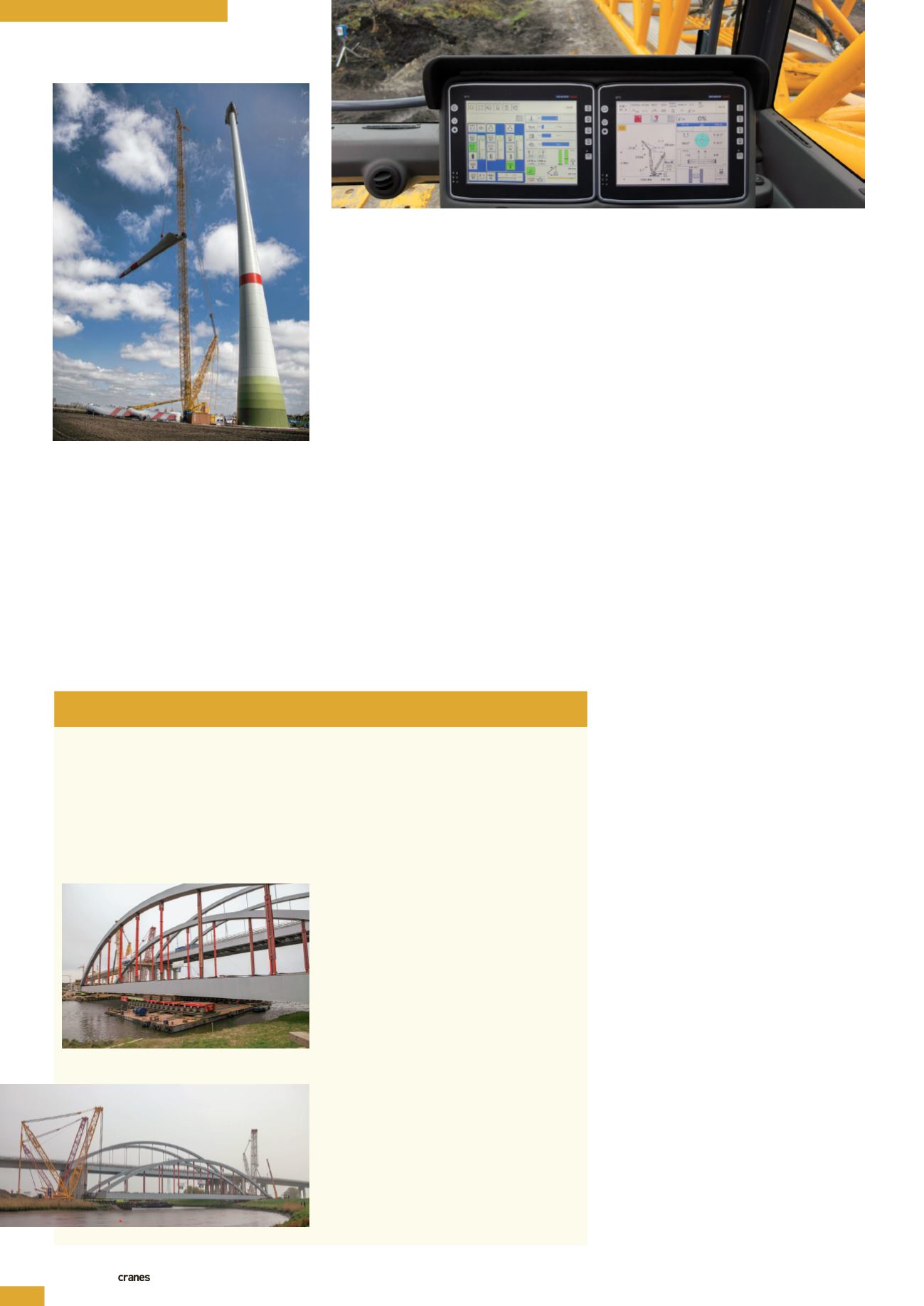
CRAWLER CRANES
INTERNATIONAL AND SPECIALIZED TRANSPORT
■
OCTOBER 2013
18
and luffing jib. The main boom length is
108 m and the luffing jib is 72 m; when
configured with the Ultralift system these
measurements are increased to 121.1 and
84 m respectively, the manufacturer adds.
Power comes from a 447.4 kW Cummins
diesel engine. Also from Sany is the
SCC8150, which can be configured with
an 82 m main boom and a 31 m fixed jib.
Capacity is 150 tonnes and it completes the
range of crawlers, the manufacturer said.
Power comes from a 316 kW Tier 4 interim
refineries. Our new LR 11000 has been
designed according to this demand.”
The LR 11000 is Liebherr’s response to
greater demand in the 1,000 tonne segment,
Beringer explains. An application is
handling offshore wind turbines and their
foundation structures at ports. It fills the
gap between the LR 1750 and the LR 11350.
The LR 11000 can have an S-type main
boom and a W-type luffing jib. It can also
have a Power Boom system with a heavy
luffing jib, the design of which has been
taken from the 3,000 tonne LR 13000.
New from Terex is the 650 tonne
capacity Superlift 3800. The lattice boom
model has a maximum load moment of
8,426 tonne-metres. Its boom system in
SWSL1 configuration is made up of the
main boom plus the luffing jib. The only
attachment needed is the LF, a light
fixed jib.
“Normally crawlers have special boom
combinations, so you have a boom for wind
and a boom for heavy lifting. However, with
the Superlift 3800 there is only one major
boom system, so you can use the same
boom sections for different applications.,"
Jakobs explains. In addition, an assist crane
is not required to erect the boom.
Operating cost is reduced with the
luffing jib, which has a runner with a one
line hook; this means when working on
a project, for example a wind farm, the
operator can lift small objects such as tools,
to the top of the turbine very quickly.
Larger future
The demand for heavy lift crawler cranes
is forecast to continue over the coming
years, especially for the increasing work
in the nuclear and other energy industry
sectors. Whether or not a new generation of
super heavy lifters will emerge to meet this
market demand is something that cannot
be predicted. As Jakobs explains, “Cranes
have to be profitable for the owner. This
means they can take jobs and perform them
efficiently. For us, crawler cranes need to be
efficient and something that will help our
customers with their business.”
“Generally speaking, the job and lift
requirements will dictate what size crane
is utilised,” Collins adds. “In the end, the
lifting needs must justify the crane size and
the cost that comes with a larger crane.”
■
A longer version of this story is at:
Crane and transport service providers Ulferts & Wittrock, Wagenborg Nedlift, and Sarens have
worked together to place a 120 metre long bridge onto 20 m tall piers.
The tied-arch bridge is part of the A23 motorway between Hamburg and Heide in Germany
and crosses over the river Stör. To carry out the lift Wagenborg used a CC 2500-1 and Sarens
used a CC 6800. Ulferts & Wittrock used its new Superlift 3800.
Before the cranes started their work the 1,200 tonne bridge was positioned ready for lifting.
This process involved two modular heavy haulage vehicles moving the bridge to a designated
place on the river bank where a pontoon waited. The first heavy haulage vehicle then drove
onto the pontoon with the bridge; the second
vehicle pushed the pontoon, together with
its load, to the other side of the river, where
a third heavy hauler was waiting. Once the
bridge was in position the three companies
were able to sling the load.
For the lift the CC 6800 was configured
with a stationary 50 m SSL configuration and
was positioned on one side of the bank. On
the opposite bank was the CC 2500-1, which
was set up in a 42 m SSL configuration, and
the Superlift 3800, which was set up with a
42 m main boom. Together the cranes
lifted the 1,200 tonne bridge into position.
Challenges during the lift included
synchronising all three cranes so the load
could be balanced.
Despite the challenges and the rain, the
bridge was put onto the 20 m piers in
five hours.
TEAM PUTS TEREX TRIO TO WORK
Cummins engine.
“The SCC8150 gives contractors a new
option in a competitive segment of the
market,” Kyle Nape, senior vice president,
Sany America Lifting Group, says. “Our
new crane delivers a combination of
control, performance, operator comfort,
power and dependability that meets and
exceeds the requirements for a machine in
this weight class.”
Heavy lifters
Over the last 12 months there have been
some new additions to the crawler crane
market at the higher end of the capacity
scale. Although there are nearly no limits
to how much a crane can lift, the higher a
crawler’s lifting capacity, the greater is the
design challenge.
“Concerning lifting capacity there are
nearly no limits,” explains Beringer, “but
these huge cranes include counterweight
systems that need a lot of space. So the
challenge is to design cranes which can
work in constricted areas, such as in
The cranes in position on
either side of the river
The bridge is put into place ready for lifting
The 650 tonne
Terex Superlift
3800 lattice boom
crawler crane has
a maximum load
moment of 8,426
tonne-metres
Inside the cab
of the 3800
of a Superlift
3800


